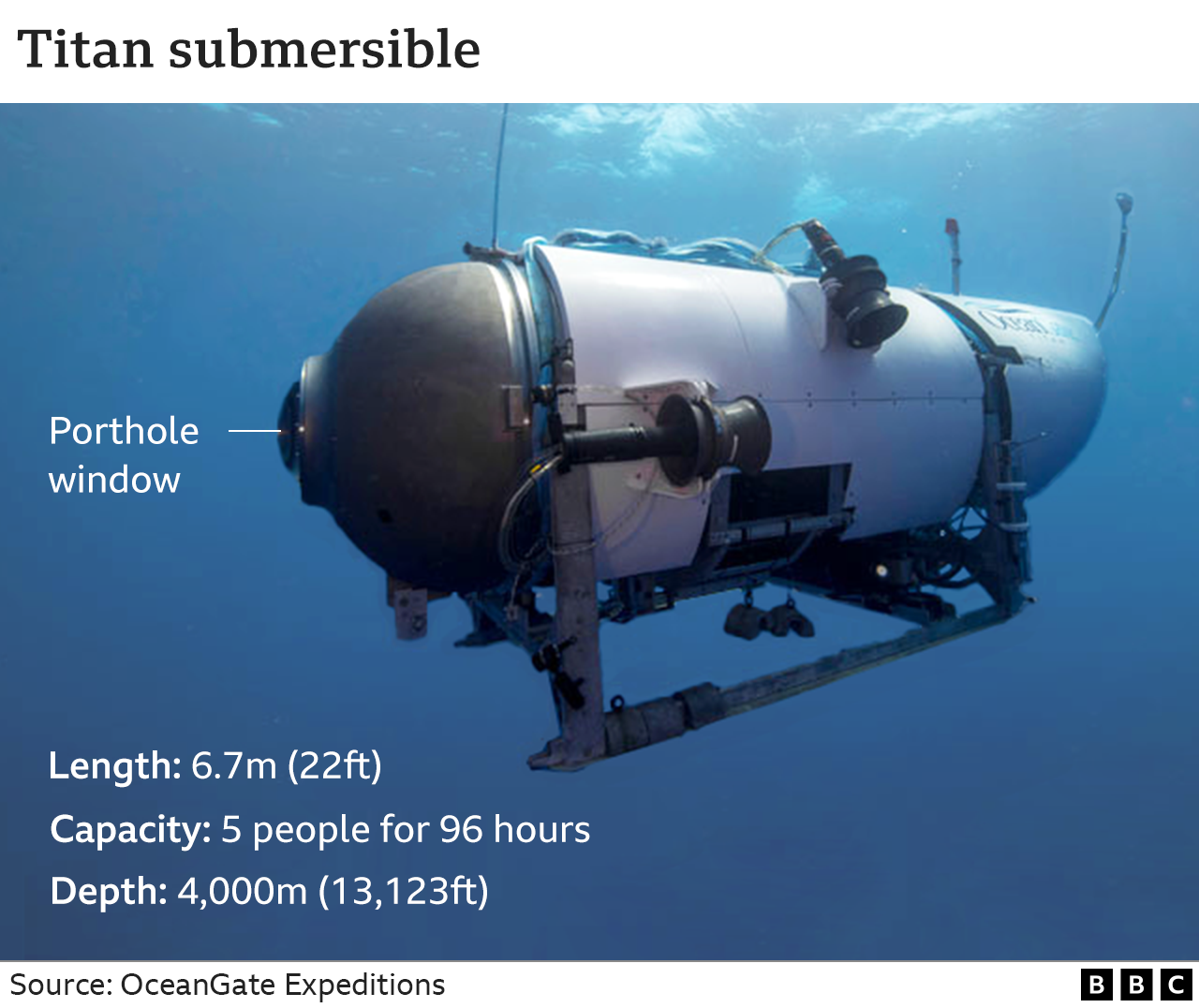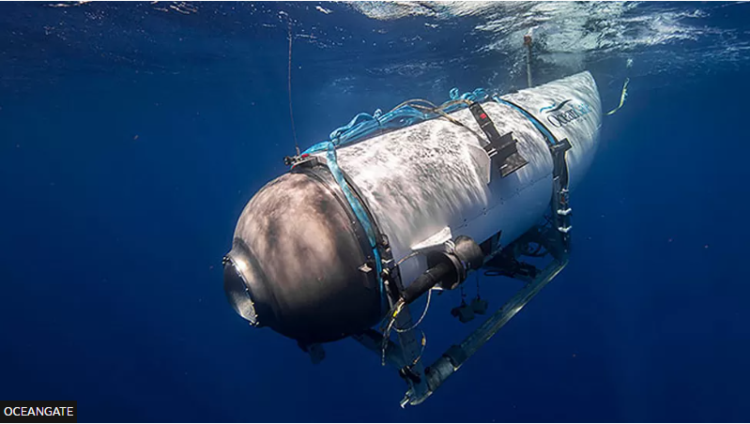A massive search and rescue operation is under way in the mid Atlantic after a tourist submarine went missing during a dive to Titanic's wreck on Sunday.
Contact with the small sub was lost about an hour and 45 minutes into its dive, the US Coast Guard said.
Tour firm OceanGate said all options were being explored to rescue the five people onboard.
Tickets cost $250,000 (£195,000) for an eight-day trip including dives to the wreck at a depth of 3,800m (12,500ft).
Government agencies, the US and Canadian navies and commercial deep-sea firms are helping the rescue operation, officials said.
Titanic's wreck lies some 435 miles (700km) south of St John's, Newfoundland, though the rescue mission is being run from Boston, Massachusetts.
The missing craft is believed to be OceanGate's Titan submersible, a truck-sized sub that holds five people and usually dives with a four-day emergency supply of oxygen.
On Monday afternoon, Rear Adm John Mauger of the US Coast Guard told a news conference: "We anticipate there is somewhere between 70 and the full 96 hours available at this point."
He also said that two aircrafts, a submarine and sonar buoys were involved in the search for the vessel but noted the area in which the search is taking place was "remote", making operations difficult.
Rear Adm Mauger said the rescue teams were "taking this personally" and were doing everything they could to bring those on board "home safe".
Hamish Harding, a 58-year-old British billionaire businessman and explorer, is among those on the missing submarine, his family said.
On social media at the weekend, Mr Harding said he was "proud to finally announce" that he would be aboard the mission to the wreck of the Titanic - but added that because of the "worst winter in Newfoundland in 40 years, this mission is likely to be the first and only manned mission to the Titanic in 2023".
He later wrote: "A weather window has just opened up and we are going to attempt a dive tomorrow."
OceanGate said its "entire focus [was] on the crewmembers in the submersible and their families".
"We are deeply thankful for the extensive assistance we have received from several government agencies and deep sea companies in our efforts to re-establish contact with the submersible," it added.
The company bills the eight-day trip on its carbon-fibre submersible as a "chance to step outside of everyday life and discover something truly extraordinary".
According to its website, one expedition is ongoing and two more have been planned for June 2024.

The submersible usually carries a pilot, three paying guests, and what the company calls a "content expert".
The trip sets sail from St John's in Newfoundland. Each full dive to the wreck, including the descent and ascent, reportedly takes around eight hours.
The OceanGate website lists three submersibles it owns, and only the Titan is capable of diving deep enough to reach the Titanic wreckage.
The vessel weighs 23,000 lbs (10,432 kg) and, according to the website, can reach depths of up to 13,100 ft and has 96 hours of life support available for a crew of five.
A vessel called the Polar Prince, which is used to transport submersibles to the wreckage site, was involved in the expedition, its owner told the BBC.

David Pogue, a CBS reporter who travelled in the Titan submersible last year, told the BBC about the issues that both the submersible crew and the land crew were likely to be experiencing, saying that there was currently "no way" to communicate with the vessel as neither GPS nor radio "work under water".
"When the support ship is directly over the sub, they can send short text messages back and forth. Clearly those are no longer getting a response," Mr Pogue said.
He added that because the passengers were sealed inside the vessel by bolts applied from the outside, "There's no way to escape, even if you rise to the surface by yourself. You cannot get out of the sub without a crew on the outside letting you out."
The Titanic, which was the largest ship of its time, hit an iceberg on its maiden voyage from Southampton to New York in 1912. Of the 2,200 passengers and crew onboard, more than 1,500 died.
Its wreckage has been extensively explored since it was discovered in 1985.
The wreck lies in two parts, with the bow and the stern separated by about 2,600ft. A huge debris field surrounds the broken vessel.
Last month, the first full-sized digital scan of the wreck was created using deep-sea mapping. The scan shows both the scale of the ship, as well as some minute details, such as the serial number on one of the propellers.
Latest Stories
-
I want to focus more on my education – Chidimma Adetshina quits pageantry
2 hours -
Priest replaced after Sabrina Carpenter shoots music video in his church
2 hours -
Duct-taped banana artwork sells for $6.2m in NYC
3 hours -
Arrest warrants issued for Netanyahu, Gallant and Hamas commander over alleged war crimes
3 hours -
Actors Jonathan Majors and Meagan Good are engaged
3 hours -
Expired rice saga: A ‘best before date’ can be extended – Food and Agriculture Engineer
3 hours -
Why I rejected Range Rover gift from a man – Tiwa Savage
3 hours -
KNUST Engineering College honours Telecel Ghana CEO at Alumni Excellence Awards
3 hours -
Postecoglou backs Bentancur appeal after ‘mistake’
4 hours -
#Manifesto debate: NDC to enact and pass National Climate Law – Prof Klutse
4 hours -
‘Everything a manager could wish for’ – Guardiola signs new deal
4 hours -
TEWU suspends strike after NLC directive, urges swift resolution of grievances
4 hours -
Netflix debuts Grain Media’s explosive film
4 hours -
‘Expired’ rice scandal: FDA is complicit; top officials must be fired – Ablakwa
5 hours -
#TheManifestoDebate: We’ll provide potable water, expand water distribution network – NDC
5 hours

